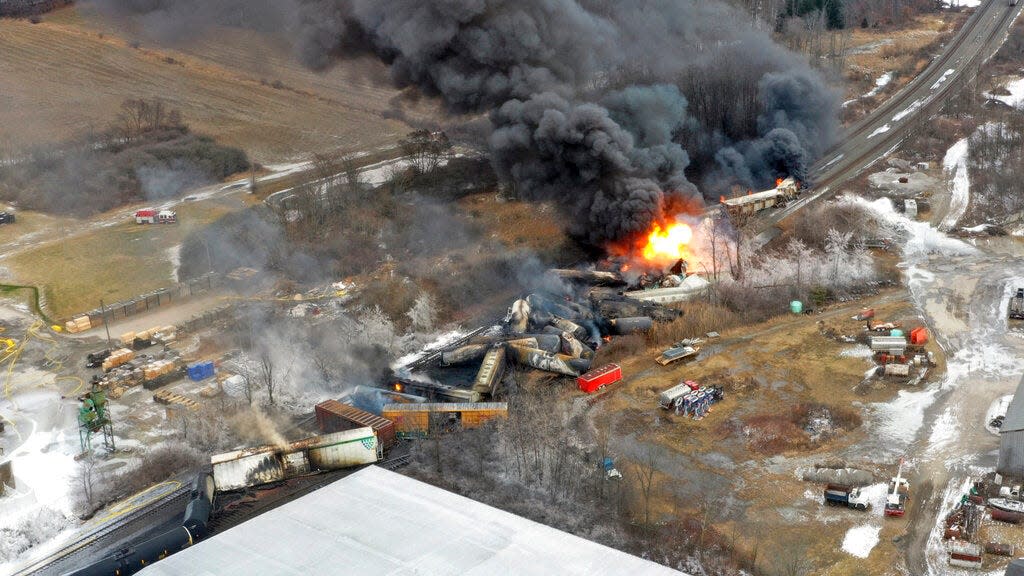Ohio train derailment: What's still unknown after chemical disaster forced evacuations?

- Oops!Something went wrong.Please try again later.
Coverage of the East Palestine train derailment is being provided for free. Subscribe today to support local journalism and access all of our content online.
The train derailment in East Palestine has already spurred evacuations and fears of ecological fallout. But, 11 days after the train came off the track, much remains unknown about the disaster
A Norfolk Southern train derailed around 8:55 p.m., Feb. 3, according to the U.S. Environmental Protection Agency. Norfolk Southern reported the incident to the National Response Center around two hours later and officials sprung to action to figure out how to handle the chemicals that were aboard some of the 50 cars that came off the track.
Ohio train derailment:Gov. Mike DeWine to provide update Tuesday on East Palestine train derailment
Residents were evacuated Feb. 6 so officials could conduct a controlled release of toxic chemicals people were allowed to return to their homes two days later. A townhall is planned for Wednesday night where more answers may be provided to East Palestine residents and Ohioans.
In the meantime, here's a look at some of what we know and other details we're still waiting on.
What chemicals were in the derailed train cars?
At least five different chemicals were carried in train cars that derailed, according to a letter from the U.S. Environmental Protection Agency to Norfolk Southern.
In the immediate aftermath of the derailment, it was reported the train cars carried vinyl chloride and butyl acrylate. But in the days since, it's also been revealed that the cars contained ethylhexyl acrylate, ethylene glycol monobutyl ether and isobutylene.
As of Sunday, the amount of ethylhexyl acrylate in the train car still hadn't been made public.
It's unclear when or whether more details about the chemicals or cargo aboard the Norfolk Southern train will be made public.
What are the long-term health implications?
Vinyl chloride, which is a chemical used to make PVC pipe, was one of the substances aboard the derailed train and is considered a carcinogen.
Exposure to vinyl chloride is associated with an increased risk of a rare form of liver cancer as well as brain and lung cancers.
Ohio train derailment:East Palestine train derailment: What we know about the situation
Burning it, which was part of the controlled release, creates the toxic gas phosgene and hydrogen chloride. The gas was used as a weapon during World War I.
With East Palestine and the surrounding areas evacuated during the controlled release of chemicals, it's unclear what the long term health risks will be to residents and people who live in nearby parts of Ohio and Pennsylvania.
Is the water safe to drink and use?
Some water in the area was contaminated after the incident, though officials are attempting to mitigate contamination. It's unknown whether the contamination will cause problems weeks, months or even years down the road.
Runoff from the derailment impacted Sulphur Run, Leslie Run, Bull Creek, North Fork Little Beaver Creek, Little Beaver Creek and the Ohio River, the Ohio EPA said. Contractors with Norfolk Southern installed a dam and water bypass at Sulphur Run to prevent further contamination of downstream waters on Feb. 10.
Norfolk Southern contractors visited homes over the weekend that were identified as having at-risk drinking water wells, the East Palestine Police Department said.
Free water testing of private wells is available through an independent contractor hired by Norfolk Southern, according to Ohio Gov. Mike DeWine's office. In the meantime, the state is encouraging people to use bottled water if they're worried about potential contamination.

Is wildlife really dying in areas around East Palestine, Ohio?
The short answer is yes, but the extent is unknown at this time.
Reports of dead wildlife have surfaced online in the days since the controlled release.
An estimated 3,500 fish have been killed in various creeks around and near Columbiana County, likely as a result of crews burning toxic chemicals after a Norfolk-Southern train derailed in East Palestine, near the Pennsylvania state line, according to the Ohio Department of Natural Resources.
The estimated stream length effected by the spill is approximately 7.5 miles, so it's possible more dead fish could show up in the coming days.
How does the derailment compare to other disasters in Ohio?
No one died or was injured in the immediate aftermath of the train derailment. Whether that will remain the case as time goes on is unclear at this point.
Ohio's nearly 220-year history is filled with tragic disasters that cost lives and caused environmental damage.
In October 1944, a tank containing the equivalent of 90 million cubic feet of liquid natural gas exploded in Cleveland, setting off the worst fires in the city's history, according to Case Western Reserve University.
Ohio train derailment:East Palestine train derailment: A timeline of what happened when
Gas entered the sewer system, causing periodic explosions that ripped up pavement and damaged utilities. At least 130 people were killed in the disaster, according to the university.
Another notable disaster was the Xenia tornado of 1974, which left nearly no building standing in the southwest Ohio city's downtown, according to Ohio History Connection. At least 33 people died in the F5 tornado and more than 1,100 were injured.
One of the deadliest coal mining disasters occurred in Hocking County in the 1930s following a buildup of methane gas that resulted in an explosion, according to the Ohio History Connection.
A trolley used by miners to carry coal caused a spark that lit the explosion on Nov. 5, 1930. The explosion, known as the Millfield Coal Mine Disaster, killed 82 people, according to the Ohio History Connection.
Dispatch reporter Eric Lagatta and Cincinnati Enquirer reporter Victoria Moorwood contributed to this story.
mfilby@dispatch.com
@MaxFilby
This article originally appeared on The Columbus Dispatch: What's still unknown after train derailment forced Ohio evacuations?
